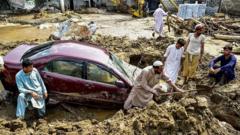More than 200 people remain unaccounted for in a flood-stricken district in north-west Pakistan, according to local officials. The recent monsoon flooding and landslides have resulted in over 300 fatalities across Pakistan and Pakistan-administered Kashmir, particularly within the mountainous Khyber Pakhtunkhwa province.
A representative from Buner district disclosed to BBC that at least 209 individuals are still missing, and this number could potentially rise. Rescue teams have reportedly interred eight unidentified bodies as no relatives have emerged to claim them, said Jehangir Khan, a spokesman for the deputy commissioner of Buner. The devastation has rendered many relatives unable to retrieve their loved ones’ bodies due to severely damaged roadways.
Provincial rescue officials revealed that "10 to 12 entire villages" have been partially buried. In addition, Asfandyar Khattak, the head of the provincial disaster management authority, indicated that "dozens" more individuals are missing in the Shangla district.
The monsoon season typically yields about 75% of South Asia's annual rainfall between June and September. However, scientists have linked climate change to the growing intensity and frequency of such weather occurrences, including landslides and flash floods.
Indian-administered Kashmir has also faced torrential rainfall, following the untimely loss of at least 60 lives due to flash floods. In Pakistan-administered Kashmir, nine fatalities were reported this week, alongside another five in the northern region of Gilgit-Baltistan.
Government meteorologists predict continued heavy rainfall in the north-west until August 21, as various locales have been declared disaster zones. Pakistan has struggled with the aftermath of this year’s monsoon since June, leading to a reported 650 casualties thus far.
Notably, Punjab, which houses nearly half of Pakistan's 255 million residents, observed a staggering 73% increase in rainfall in July compared to the previous year. The accelerated loss of glacial mass in northern Pakistan, caused by climate change, poses an additional risk; the melting ice destabilizes mountain faces, increasing the likelihood of landslides that can block rivers.
While investigations are ongoing to determine the root causes of the recent floods and landslides, glaciers' retreat and increased runoff are believed to contribute significantly to these disasters.



















